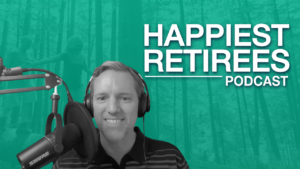My son Jake is 9 years old. On a recent trip to Michigan, he and I played golf together. No one would mistake him for the Golden Bear or Tiger Woods, yet. Sometimes he hits a decent ball and sometimes it sputters 3 feet in front of the tee. One day, he may become a legend of the links. Or, maybe he won’t. What matters most is that he loves to play and improve.
Amid our 18 holes of father-son bonding time, we came upon a fairway with a beautiful red oak 120 yards down the line, smack-dab in the middle. “Dad, can you hit it over the tree?” Jake asked. “No way,” I said. “Too difficult. Our only hope is to hit left or right and go around it.” In fact, it was such a difficult shot that my plan was to aim for the tree and depend on my lack of accuracy to carry the ball safely around it.
All of a sudden, Jake piped up. “Dad, what if I hit the tree?!” “No way, JJ! Not gonna happen. In fact, if you manage to pull that off, I’ll give you $100.” I may or may not be licensed to gamble in Michigan, but it didn’t matter because no money would ever change hands. There was simply no way he would bull’s-eye the burgundy bark of that sturdy trunk.
You know where this is going. Jake hits the best shot of the day, straight down the middle of the fairway. The ball whacked the center of that tree like it was destiny.
I handed my son a $100 bill that day. And that’s only half of the story.
That following Monday, we climbed into the MossMobile for the trek home — northern Michigan to Atlanta, all in one day. That’s my wife, four kids, me, and a dog for 16 straight hours, save for gas and food stops.
At a gas station en route, Jake wanted to buy his brother a snack. The big-time golfer with the big-time cash said, “Put your money away, bro. I got this.” And that’s when he realized that his deep pockets were actually empty — the $100 bill was gone.
The little guy had hidden the legal tender in the bedroom drawer of our rental house in Michigan. In his attempt to save and protect the profit, he lost it all. Gone.
He came back out to the car where I was finishing filling up the tank and said, “Dad, I’m so mad!” “I know,” I said. “It’s no fun to be in the car that long.” “No, Dad! Not that. I lost my $100 bill!” Tears followed. “This is the worst day ever!”
We’ve all been there. You wait all week for that ice cream cone and then drop it on the floor before the first bite.
As we got back on the road, our family heard more about Jake’s pain and his terrible, horrible, no good, very bad day. Not to mention a whole litany of items he could have purchased if he still had that $100 bill.
It clicked for me after a while that I’d heard similar rumblings from investors over the years. I realized this was a teachable moment for my children.
“So today is the worst day of your life?” “Yes.” “OK, then was it your best day when you won the $100?” He was silent. “So, was the pain of the loss stronger than the joy of the win?” “Yeah, Dad. It’s confusing, but the losing was worse!”
This is a 9-year-old boy. Never traded stocks. Never paid taxes. New to the idea of money. And yet, he already possessed this instinct. It dawned on me just how ingrained, genetically, this phenomenon is. It’s the very thing you and I face every day as investors. It’s called Loss Aversion.
Loss aversion is a cognitive bias that describes the psychology of why the pain of losing money, or any valuable object, is twice as powerful as the pleasure of gaining it. Simply put, our brain thinks it’s better not to lose $100 than it is to win $100.
Now that we’ve identified the reality of the problem, what can we do about it?
It’s a tough one because we are literally wired this way. Imagine training yourself not to react to touching a hot stove. It would be very difficult. In that case, nature is helping protect you, but in the case of investing, nature doesn’t realize it’s actually hurting you.
The way to retrain your mind is through education, understanding investment history, practice, and having an investment plan.
Education
The good news is that by reading this, you’ve already begun learning. Acknowledging the reality means you know it’s a problem. And knowing is half the battle.
Understanding market history
No one likes to see a loss in his or her portfolio, but panic leads to bad decisions. The U.S. economy takes its share of hits but typically recovers. Most of the time, stocks will follow suit. Learn to breathe through the tough moments.
Practice
Literally, getting in the game is a big part of investment success. It takes practice to watch the market drop as it did recently and not pull your hand back from the hot stove. Make a point of forcing yourself to hold firm. Keep moving forward with your long-term plan. Before you know it, your brain and emotions will follow suit.
Investment plan
All of this fortifies the importance of identifying the investment plan and strategy that you believe in. I am partial to dividend and income investing, but there are certainly many other ways to approach it. Some investors like private equity over public equity. Others prefer high growth over income or real estate. Understanding all of these areas is part of the equation.
When Jake lost his $100 bill, it hurt but what were the chances of him losing it? I don’t know, but what I do know is that if he had never taken that beautiful swing and driven that ball down the fairway, his chances of earning would have been zero.
Learn from Jake’s bravery and pain. The next time he has an opportunity to take a swing, I hope he goes for it. And I want the same for you.
Read the AJC Article here.
Disclosure: This information is provided to you as a resource for informational purposes only. It is being presented without consideration of the investment objectives, risk tolerance or financial circumstances of any specific investor and might not be suitable for all investors. Past performance is not indicative of future results. Investing involves risk including the possible loss of principal. This information is not intended to, and should not, form a primary basis for any investment decision that you may make. The information contained in this piece is not considered investment advice or recommendation or an endorsement of any particular security. Further, the mention of any specific security is solely provided as an example for informational purposes only and should not be construed as a recommendation to buy or sell. Always consult your own legal, tax or investment advisor before making any investment/tax/estate/financial planning considerations or decisions.










